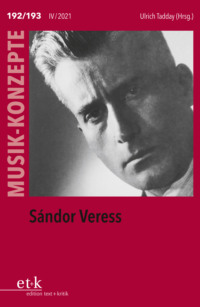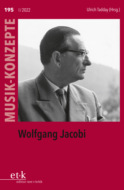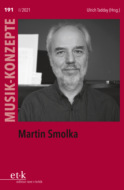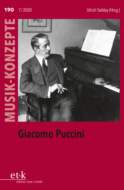Kitabı oku: «MUSIK-KONZEPTE 192-193: Sándor Veress», sayfa 3
CLAUDIO VERESS
Zu einem unerwarteten Fund in der Musiksammlung der Budapester Széchényi-Nationalbibliothek (OSZK)
Sándor Veress’ Bühnenmusik zu Imre Madáchs Az ember tragédiája (Die Tragödie des Menschen)
Ein kürzlicher Quellenfund soll hier genauer angezeigt werden, da er ein zumindest außerhalb Ungarns lange verschollen geglaubtes Werk betrifft, das Veress während seiner Londoner Monate 1947 intensiv beschäftigt hat: die Bühnenmusik zur Neuinszenierung von Imre Madáchs Az ember tragédiája (Die Tragödie des Menschen) am Budapester Nationaltheater (Nemzeti Színház) unter der Regie von Béla Both, die am 26. September 1947 Premiere hatte und während der folgenden Wintersaison insgesamt 89 Mal gegeben wurde.1 Es war die letzte Inszenierung des Stücks vor der stalinistischen Wende, danach wurde es – weil angeblich unrettbar durchtränkt von reaktionärem Ungeist – bis zum vorrevolutionären Tauwetter des Jahres 1956 auf den Index gesetzt.2
Nichtsdestotrotz handelt es sich bei diesem 1862 erschienenen Text um einen Klassiker, eine Art ungarischen Faust, der sich als »dramatisches Gedicht« in 15 Bildern – zumeist in Blankvers – entfaltet. Die Bilder 1 bis 3 sowie 15 bilden eine an die Wette des Buches Hiob und die Sündenfallerzählung der Genesis angelehnte, im Paradies bzw. außerhalb des Paradieses spielende Rahmenhandlung, in die ein Adam und Eva durch Luzifer eingegebener menschheitsgeschichtlicher Traum über elf Stationen eingewoben ist – insgesamt eine Antwort auf Adams Frage nach der Zukunft der Menschheit, die nach einem Panoptikum immer wieder erneuerten Strebens und Scheiterns in der Dystopie einer »eisigen Gegend« nahe dem Äquator (!) endet. Nach dieser luziferisch-zynischen Belehrung erwacht und radikal desillusioniert, steht Adam im 15. Bild kurz davor, sich in einer Aufwallung verzweifelter Selbstermächtigung von einem Felsen zu stürzen, als ihm Eva eröffnet, sie sei schwanger. Das ist der Augenblick, in dem Luzifer seine Wette um die Menschheit gegen Gott verliert, dieser das sündige Paar wieder in seinen Gnadenkreis aufnimmt und ihm das Gebot auf den Weg gibt: »Mensch, dein Gebot sei: kämpfen und vertrauen.«3
Das Stück ist kein reines Sprechdrama. Vielmehr zeigt es mit seinen vielen (vokalen und instrumentalen) Einlagen einen – letztlich in Mysterienspiel-Tradition stehenden – Hang zum Gesamtkunstwerk. Daher wurde es seit seiner Budapester Uraufführung 1883 stets unter Beizug von Bühnenmusik inszeniert. Veress steht mit der seinigen zwar äußerlich in dieser Tradition, war aber anscheinend der erste Komponist, der im Aufbruchsklima der Nachkriegszeit einen Traditionsbruch im Sinne seines Verständnisses von neuer ungarischer Musik herbeiführen konnte.
Die Briefe vom ersten Halbjahr 1947 berichten an mehreren Stellen von Veress’ Schwierigkeiten, unter den in London obwaltenden Umständen mit der Komposition ins Reine zu kommen, von der Anfang April immer noch Ouvertüre und Schluss fehlten.4 Am 27. Juli notiert er entnervt: »Jetzt bekomme ich hässliche Briefe und Telegramme (vom Nationaltheater), die nach der Tragödie fragen – dieses ist also wieder meine eigene Tragödie geworden.«5 Da die Korrespondenz mit seiner Frau just nach diesem Brief abbricht und bislang auch sonstige Belege fehlen, wissen wir nicht, wann das Budapester Nationaltheater in den Besitz der noch fehlenden Teile gelangte. Das jüngst im OSZK zum Vorschein gekommene Aufführungsmaterial6 scheint aber vollständig, wenngleich (mit einer einzigen autografen Ausnahme) von mindestens zwei Kopisten-Händen geschrieben. Das Material umfasst lediglich die Orchesterstimmen, die Partitur scheint verschollen. Jedoch ließe diese sich aufgrund der Stimmen rekonstruieren. Die Besetzung des Orchesters umfasst 2 Flöten, 2 Oboen (2. auch Englischhorn), 2 Klarinetten, 2 Fagotte (2. auch Kontrafagott), 2 Hörner, 3 Trompeten, 2 Posaunen, Harfe, Pauken, Schlagzeug (kleine Trommel, Becken, große Trommel, Triangel), Streicher. Der Streicherkörper musizierte in der Besetzungsgröße 8 – 6 – 4 – 4 – 2.
Die Nummernfolge der Bühnenmusik folgt weitgehend der Bilder-Folge des Dramas, umfasst außer der Ouvertüre 14 Einheiten (Bild 10 bleibt als einziges ohne Musik), die wiederum je nach musikalischen Erfordernissen der Bilder mehr oder weniger stark untergliedert sind. Auf eine genauere Beschreibung muss im vorliegenden Rahmen verzichtet werden.
Einzig zwei besondere Befunde seien hervorgehoben: Erstens die Entdeckung des, wie es scheint, einzigen autografen Blattes im gesamten Stimmenmaterial (Abb.): einer Partiturnotation des Harfe-begleiteten Liedes der römischen Hetäre Hippia (Veress schreibt irrtümlich »Cluvia«) im Rom-Bild (Nr. 6). Der Text lautet in Übersetzung: »Liebe und Wein / Lass nimmer sein. / Andere Würze / Hat jeder Becher. / Der Rausch, die süße Wonne / Vergoldet unser Sein, / Wie versunkene Gräber die Sonne.«7 Die Kontur der Melodie ähnelt auf überraschende Weise einer authentischen Volksmelodie, schärft diese in T. 5 aber noch auffällig modal (a – a – f) aus.8 Beobachtungen dieser Art könnten die Hypothese stützen, dass dem – seinem ganzen Textcharakter nach schon so unverwechselbar ungarischen – Drama Madáchs durch Veress’ Bühnenmusik nochmals merkliche Zuwächse einer spezifisch musikalischen couleur locale beschert wurden, die erst auf dem Boden der »musikethnografisch informierten« Ästhetik der Bartók-Kodály-Schule möglich geworden waren. Erhärten ließe sich diese Vermutung freilich nur durch einen genauen Vergleich mit den ebenfalls in der Széchényi-Bibliothek aufbewahrten Vorgängern der Veress-Musik.
Die zweite Beobachtung besteht in der Merkwürdigkeit eines in die Innentitelseiten der meisten Stimmen montierten Textmottos, das Veress dem London-Bild (Nr. 11) der Tragödie entnommen hatte. Es lautet in Übersetzung: »Adam (zu einem der Musiker): ›Gefällt dir denn die Weise, die du spielst?‹ / Der Musiker: ›Beim Himmel, nein! Im Gegenteil, ’s ist grässlich / Tagtäglich eine Melodie zu geigen, / (…) Es hallt mir noch im Traume nach. Jedoch / Man muss ja leben (…)‹«9 Anscheinend handelt es sich hier um eine ironisch maskierte, nichtsdestoweniger solidarische Botschaft des Komponisten an »seine« Musiker, um deren schwierige Produktionsbedingungen unter den damaligen Umständen des Budapester Theaterbetriebs er genauestens wusste.
1 Ich danke Gyula Lencsés (Szeged) herzlich für diese Information und für vielfältigste Hilfe beim Recherchieren der Quellenlage zur Inszenierung. — 2 György Dalos, 1956. Der Aufstand der Ungarn, München 2006, S. 36–38, 244. — 3 Imre Madách, Die Tragödie des Menschen. Ein dramatisches Gedicht, mit einem Vorwort von Marcell Benedek, übersetzt von Jenő Mohácsi, bearbeitet von Géza Engl, Budapest 91998, S. 230. – »Mondottam, ember: küzdj és bízva bízzál!« (Madách Imre, Az ember tragédiája, Budapest 2006/18, S. 197). — 4 SV an EV, London, 6.4.1947 (PSS, SSV). — 5 SV an EV, London, 27.7.1947 (PSS, SSV): »Now I get nasty letters and telegrams asking for the Tragedy (from the Nemzeti), so this has become my own Tragedy again.« — 6 Mappe mit der Aufschrift: Nemzeti Színház: Az ember tragédiája / új zenéje 1947–48-ból. / Zene: [Veress Sándor] (Sig. Népsz. 1101/X. köt.). — 7 Madách, Die Tragödie des Menschen (Anm. 3), S. 75. – »Borral, szerelemmel / Eltelni sosem kell; / Minden pohárnak / Más a zamatja. / S a mámor, az édes mámor, / Mint horpadt sírokat a nap, / Létünk megaranyozza.« Madách, Az ember tragédiája (Anm. 3), S. 60. — 8 Béla Bartók, Das ungarische Volkslied, Berlin – Leipzig 1925, Faksimile, hrsg. von D. Dille, Budapest – Mainz 1965, Notenteil, S. 26, Melodie Nr. 93c (unten). – Dank an Andreas Traub für diesen Hinweis. – Das Manual Béla Boths zur 1947er Inszenierung: Madách Imre, Az ember tragédiája / Rendezőpéldány / Both Béla / Utasításaival, Budapest 1948, bietet S. 170–174 fünf instrumental-vokale Exempla, darunter eine nicht mit Veress’ Komposition identische – also vermutlich ältere – Version des Hippia-Liedes. — 9 Emerich von Madách, Die Tragödie des Menschen. Dramatisches Gedicht, aus dem Ungarischen übersetzt von Andor von Sponer, Leipzig 1891, S. 122. – »Ádám: ›Mondd, tetszik-é, amit húzasz, magadnak?‹ / A zenész: ›Dehogy tetszik, dehogy! Sőt, végtelen kín / Ezt húzni napról napra, (…) / E vad hang elhat álmaimba is. / De mit tegyek, élnem kell, (…)‹« Madách, Az ember tragédiája (Anm. 3), S. 133.
II Sándor Veress in der Kompositionsgeschichte: Fremd- und Selbstzeugnisse

SÁNDOR VERESS
New Trends in European Music since World War II
Herausgegeben von Thomas Gerlich 1
There is a proverb which says: »You cannot see the wood for the trees.« It is very much the same if one intends to talk about the musical situation of our days. Much time will have to elapse before it will be possible to find the right perspective out of the present maze of opponent trends, before the right measures can be applied to winnow the chaff from the wheat. There was never before a time in the whole history of Western civilization – or, with other words, Christian culture – when so many categorically different trends, views, doctrins, theories or philosophies existed, being entangled in a manifold conglomeration of diversities. And, as in the three main sectors of human existence, in the cultural, political and social fields, so it is also the most prevalent feature of contemporary music its polymorphic density of adverse categories.
Not as though in the history of Western, that is to say European culture uniformity had ever been the characterizing factor. On the contrary, the main essentials of our culture are, in difference to the great but static oriental cultures, its permanent conversions through the inherent forces of renewal. Consequently in all times this very typical diversity of trends, ideas etc. manifests itself clearly. Either as style-forming groups – like for instance the so-called mannerism in literature and painting and also in music of the 16th and 17th centuries – or as individual extremities which always were existent in literature and the arts. In view of these facts many symplifying generalizations will loose their absolute value if one would investigate, for instance, the question whether J. S. Bach has not been a romantic, while Chopin a classic composer?! In Bach’s music is as much romanticism to be found as classicism in Chopin’s art. Or to mention another striking example of simultaneous plurality of opposing trends: one could hardly imagine a bigger difference in style and artistic attitude than that of the madrigalist Don Carlo Gesualdo, Duke of Venosa, and of the Choir Master of Sistina Chapel in Rome, Giovanni Pierluigi da Palestrina. They were contemporaneous, Palestrina, being the elder, died in 1594, Gesualdo in 1614. Palestrina, whose tombstone in St Peter’s Basilica bears the epitaph »Musicae Princeps«, is the incarnation of the greatest traditional accomplishment in music, while Gesualdo in Ferrara wrote at the same time his madrigals which in their modern harmonic keenness lie almost near Wagner!
Also in the development of science there were great revolutionary events similar to our age. The process, for instance, of changing over the perceptive faculty of man from the sacred Ptolemaic astronomic conception to the Copernican heliocentric system which almost a hundred years later still had to be defended by Galilei (at the near cost of his head by the Inquisition) has been at least as much stirring an occurrence as the discovery of the atom bomb – though in its consequences to humanity certainly less dangerous.
One could go on mentioning these parallels between our century and those of earlier ones indefinitely to prove that our times, regarding the manifold simultaneous existence of opposed trends, do not differ much from former centuries. And yet, I think the difference is very great. As great namely as the disparity between the situation of man in our times in comparison with earlier centuries. None of our problems, none of our quarrels, nor our joys or sorrows and fears, our achievements or setbacks and failures are anymore a family business as they were more or less till the 18th century. They all became world-wide, their significance grew global and the time is not very far when they will be even super- or extra-global. But by this perplexing expansion of the dimensions both horizontally and vertically, both in the realms of our spiritual as well as material existence, all problems became and continue to be more and more complex. By this complexity a process of splitting up into many particles has set in at every sector of cultural, political and social fields with the acute danger of disintegration. Like our big towns which grow to such inhumanly monstrous size that within a metropolis already more and more smaller units begin to form many separate parts with their own schools, libraries, store houses, concert halls etc., and also with their own provincialities, with a population getting more and more isolated and disintegrated from the whole.
On the other hand only a small elite is able to keep step with this development while a considerable majority – partly resulting from a lack of proper education – became the procreation of that alarmingly increasing hideous part of modern society which already some 35 years ago has been investigated by Ortega y Gasset in his famous book The Revolution of the Masses. The last half century of European history with its red and brown masses furnish us with enough evidence of the peril of this development.
Now, Ladies and Gentlemen, you could certainly say that you came to hear about music instead of sociology. But man is a product of his surroundings and of the times he is living in while music is the product of man. Therefore, if we want to analyse the present state of our musical situation we cannot do this without investigating the situation of man within our present cultural, political and social circumstances and the manifold currents in our cultural world. In view of this I would like to summarize once more the main points of my former reflections.
a) First I’ve mentioned the polymorphic density of adverse categories as a prevalent feature of our times. By drawing a parallel with former centuries I came to the conclusion that this simultaneous existence of opposed trends, being one of the main characteristics of European culture, has always been a decisive factor of Western civilization. As a striking example to this observation in the musical field I mentioned the music of Gesualdo and Palestrina, which, of course, is only one among countless similar other phenomena. However, when looking deeper into the problems of our times one comes to the conclusion that, in spite of the similarity regarding the numerous opposing trends, there is a substantial difference between earlier centuries and that of our age. We shall see that this is exactly the same perspective in our present musical situation. The differences are no more the same ones like between Gesualdo and Palestrina.
b) We also saw that by the expansion of the dimensions all our present problems became highly complex, but that in the meantime this complexity also bears the signs of a perilous desintegration. We can observe the same process in contemporary art.
c) Finally, the increasing gulf between an elite and the masses in our 20th century society has its equivalent appearance similarly in contemporaneous musical production and practice.
Now to the question: Why are the differences in music today other than in the time of Gesualdo and Palestrina? After all we talk today about »modern« and »old« respectively »traditional« music just as in the 16th century they talked about »stylus modernus« and »stylus antiquus«. Terms like »ars nova« and »ars antiqua« have been used even earlier, in the 15th century. There was great rivalry between the madrigalists like Gesualdo or Luca Marenzio whose music was called »musica moderna« and the more traditional composers like Palestrina or Lassus, the representatives of the »musica antica«. The new style of those times, the »stile concitato« – the inciting style – with its »capricci stravaganti« and »consonanze stravaganti« – the extravagant caprices and consonants –, the keen chromatic harmonic progressions, modulations, unusual melodic intervals, extraordinary »false relations«, syncopations etc. delighted and excited the younger and shocked the elder generations that time just as did every revolutionary musical novelty of later times till about the well-known scandal at the premiere of Sacre du printemps in 1913. But while every change of style, every new epoch in the history of European music since the beginning has always been in character an additional or gradual and not a qualitative-substantial transformation, with initiating the dodecaphony method, the composition with twelve tones by Schönberg, a derivation in European music has started which – at the present stage – led to a state where, I think, we have to revise entirely our traditional customary conception about music as it existed since the Gregorian chant, and have to think in basically new categories if we want to define that sound phenomenon which is produced by various groups of a so-called Avantgarde composers since World War II, by extending and developing the theoretical principles of the Viennese school between the two world wars. I think it is a mistake to call this sound phenomenon »music« because by doing so certain associations will inevitably determine our thinking. But when these associations do not cope with the reality – in this case with that sound phenomenon – there will be a discrepancy between our imaginary conception relating to music and the actual sound we are listening to, with the result that by not finding [what] we expected, our spiritual and mental condition will greatly be disturbed. And I would call it a spiritual disturbance also if one feels hopelessly dull when listening to sound not in relation to music.
Now with this we arrived at that point where I would like to refer to my previous intimation that the diversities in our times cannot be compared with the situation of previous ages because today the diversities represent also completely different species. So we have to deal today roughly with two opposed ways of thought in music: with that of the tonal and of the atonal, respectively extra- or paratonal ones. Further in both fields, the tonal as well [as] in the atonal regions, there are numerous subdivisions, all representing different shades of the same artistic idea, or different levels in dealing with the same artistic problem. This complexity of the musical situation after the Second World War is increased by the social aspect of music. All arts in all times had always a social function. Without this social function no art and no artist could ever exist. With the splitting up [of] our social structure, with the disappearance of values which determined life for centuries, with the increase of mass civilization a substantial change can be observed also in the social function of music. On one side there is an enormous popularization of music; and not only of light music but also, in the good sense of the word, [of] a great deal of classical music. The consummation of music through our mechanical devices became tremendous although the general cultural standard of humanity has not risen by listening to the 5th Beethoven symphony on the radio while eating lunch. But then, parallel with this progressive popularization, a radically opposed trend – partly also as a reaction to it – can be observed, a sort of extreme individualism leading to esoteric spheres, and this not only in music but also in contemporary painting and sculpture. It seems as though the aim of the artist would be to withdraw himself into a self-erected ivory tower where he ab ovo resigns – except in case of small groups of conformists – to a brighter basis for his art. I think, this is a misunderstanding on both sides, on the artist’s as well as the public’s side. Since music always, from the beginning, has been a means for expression (even if this is not expressed in a concrete way), human beings will instinctively search for something like an immanent spiritual context, similar to that undefinable effluence one feels when listening, for instance, to a Bach fugue. However, it is one of the main characteristics of the so-called abstract music – the word is rather absurd for all music is abstract – that it does not want to express anything. This music cannot and does not need to be understood. Here too, there seems to be a categorical difference to previous times. Sacre du printemps was not understood by a wider public at its premiere but in spite of this, or because of this, it caused a big scandal, for that immanent effluence of the music reacted on the subconscious of people and stirred them up into a real rage. Later, after some time, it was understood by larger groups of people and today it is no more problematic even to the average concert listener. Abstract, atonal or paratonal music causes very seldom scandals and it never will be understood in the usual sense of the word. Because in this music there is nothing really which can be understood. It does not claim to be understood because this sort of music is an attitude, not an expression. Just like a crossword puzzle does not claim understanding, for its purpose is not the understanding but the playing with words. Abstract music too is, at first rate, a play with sound elements, an intellectual enjoyment at the figuring out of mathematical constructions by means of acustical phenomena. Or, as the latest development shows, a purely sensuous sonorific sensation. In fact, to unriddle the secrets of an intricate musical construction in these scores is often a much bigger satisfaction than the actual impression of a performance. Therefore it would be erroneous to call this music unnatural, dadaistic, sectarian, schizophrenic and so forth, as it is often criticized by people who are not prepared to take this sound phenomenon for what it really is. Because with this a comparison is drawn between two things which are not analogous.
As a sort of diagnosis I would quote in regard to the situation Professor Stuckenschmidt of West Berlin, who says:
»We must erect ivory towers. We have to build again small communities of iniciated individuals for whom the dealing with extreme intellectual problems gives a meaning to life. I see among the European youth a few creative musicians whose starting point is the extreme form of an avantgarde musical tradition, whose idol is the extremely introvert art of Webern«.
This is the other end of the stick, but in addition it must be noticed that the disposition of our 20th century cultural aspect also differs from previous times pre-eminently. It is typical of our age that in the cultural sense man orients himself in time and space since the 18th century increasingly bisected.2 With the technical development still greater regions of humanity’s past and a steadily increasing scope of our present earthly space with a strong vision projected into the future are becoming a reality. An immense amount of knowledge about the past is for us today a constant actuality and determines our thinking as well as our spiritual reactions. This was not always so. For a musician even of the 17th century still his own time and the style of his own age was the reality. Beginning and end of a style was determined by the work of generations starting or finishing an epoch. Even 19th century romanticism has been so self-contained as to claim the highest achievement in music for itself. Today this has changed fundamentally. Our age is in a certain way an eclectic one and nobody can really free himself from the influence of the ever-present past in spite of our immense technical accomplishments. Except if we would agree to demolish our Roman or Gothic cathedrals, such wonders like Murbach, Durham, Tournai, Chartres or Lucca, Siena, and so forth. (Although one notices with a sense of the utmost apprehension that the number of people for whom these marvels do not mean more than a touristic attraction is increasing rapidly.) Therefore I think, it is a misunderstanding of the very nature of our age to assert that the starting point of contemporary art is the »extremely introvert art of Webern«, although actually, in practice all the avant-garde composers followed this course. However, I think that with the complexity of our age there are also several starting points. Still, apart from this, it seems to me that not so much the starting, but rather the point of continuation is the more vital factor in our present situation.
Furthermore, popularity and introvert intellectualism is complicated by political factors. In all the so-called socialist countries where an obsolete, reactionary marxist-leninist philosophy is forced upon such subtle and sensitive spheres like art, music too is regarded as a means of political indoctrination. According to this, art must serve the masses, it must be popular, and especially since a general in Moscow had a bee in his bonnet of being as great an expert in music as in the art of war, through the brutal establishment of Shdanowism great damage has been inflicted upon contemporary art in those regions. Here we have to deal with the utmost primitive conception about art, and in particular about popular art, and also with a conception representing a basically anti-intellectual attitude. According to the party doctrins of the Chinese Communist Party »the young progressive musicians of China, who are inflamed by the great ideas of Marxism-Leninism, are eager to serve the folk, to speak an idiom understood by everybody and to educate the spirit of patriotism and national pride«. This is popularized anti-intellectualism, music demanded with no other function than to appeal to the most primitive reactions of the masses – an anti-intellectual barbarism. Or, as Walter Wiora says: »Strict popularity became the norm for the composers of socialist states intending through this process to achieve social progress, similarly the avant-garde in the West represents the artificial progress.« On the other side there is extreme, esoteric intellectualism, often a sterile play with sounds, a total break with European tradition to the extend of self-annihilation where music making – the innermost subtle form of self-expression as in singing – is given over to machines. This, of course, approaches the state of intellectual barbarism!
These are the two antipodes in our present musical situation representing the extreme forms of tonal and atonal as well as extra- and paratonal music. In that wide gap which lies between both sides of the gulf there is a multitude of different shades, trends, technics, styles adhering to one or the other direction or taking an independent position.
By regarding this development in the perspective of about half a century (the speed is not less than that in the technique!) one can locate roughly the following main stages of a cycle: Arnold Schönberg (in his disposition basically a romantic) comes intuitively to the idea that by systemizing the atonal material a solid theoretical basis could be laid down to handle the musical sounds which, by the end of the romantic period, somehow begun to disintegrate through intensified application of chromaticism. Schönberg, contrary to his contemporaries like Stravinsky or Bartók, was not a revolutionary and his contribution to European music was also a logical evolution of trends already inherent in late romanticism with the aim to make order in a commencing disruption and, by connecting the classical form conception with his dodecaphonic system, to give music a firm frame again as it had in the classical periods. Today it is evident that in Schönberg’s conception, otherwise worked out with clear logical thinking, this idea was a fatal error which led to many conflicts. All classical forms live from functional tensions provided by a tonal order of sounds within a tonal system. No traditional form like fugue, rondo, sonata, etc. can exist if it is deprived of this vital element. Because with this its possibility of unfolding itself to a musical architecture is cut dead, and the form remains only a meaningless sceleton instead of being the body of the music. This is the reason why dodecaphonic music sounds static, like a sort of structure of tones revolving around themselves instead of moving forward in time like all tonal music.
Both of Schönberg’s pupils and later friends, the two other leading personalities of the Viennese school: Alban Berg and Anton Webern have felt this deficiency of Schönberg’s twelve-tone method and went different ways. Berg, by giving vent to his passionate romantic nature, gradually reached more freedom in the handling [of] the dodecaphonic material through which his language became fascinatingly expressive and suitable for big forms. Webern, whose spiritual disposition in contrast to Berg was rather that of a puritan ascetic, went the opposite way and, by conducing the system to its last possible consequences, reduced it to its basic elements with the result that his musical language, being of the utmost concentration, became unsuitable for a larger, expressive rhetoric. But he actually realised that the dodecaphonic system must also be combined with another form conception than that of the traditional one. The thought of serialism, the integration of the musical elements into a total organisation, was Webern’s contribution and it is precisely this point to which the post-war avant-garde generation switched on. Although the perils of disintegration through over-complexity were not unknown, as the significant words of Leon Dallin, written in 1957 in his book Techniques of Twentieth Century Composition, show: »Few would be tempted to follow in Webern’s footsteps all the way, so perhaps it is superfluous to warn that to do so probably would prove to be artistically fatal.« These were words of great vision and the present situation gave them right.





